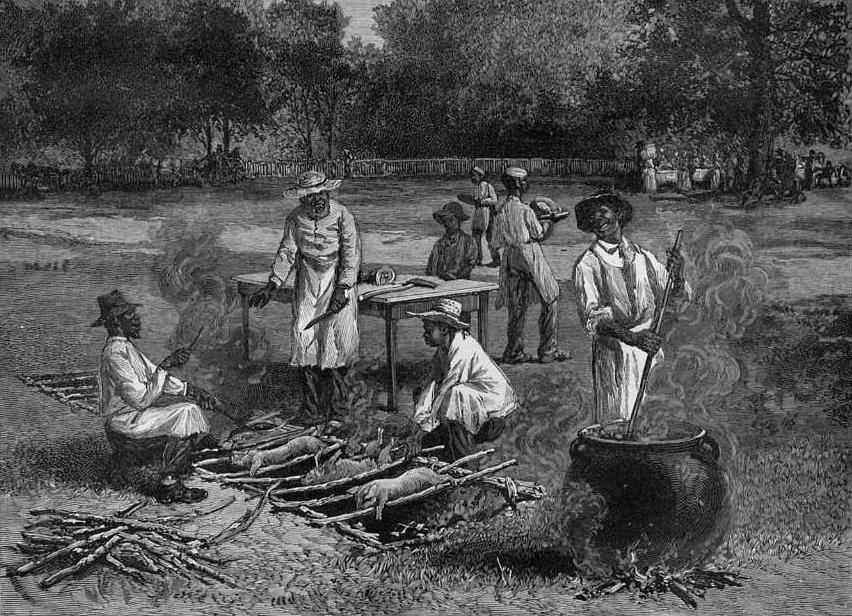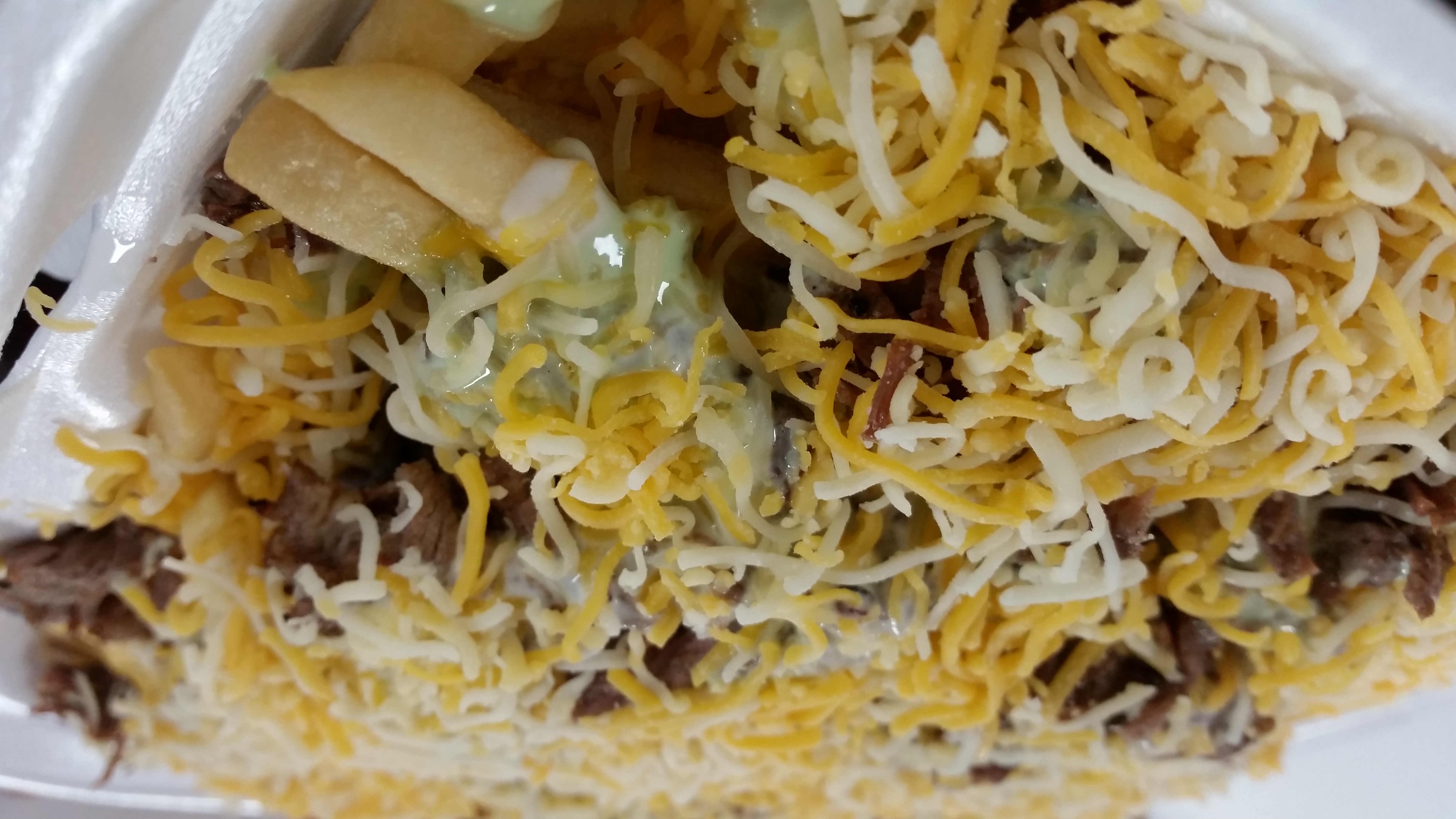|
Santa Maria–style Barbecue
Santa Maria–style barbecue is a regional culinary tradition rooted in the Santa Maria Valley in Santa Barbara County on the Central Coast of California. This method of barbecuing dates back to the mid-19th century and is today regarded as a "mainstay of California's culinary heritage". The original Santa Maria-style barbecue consisted of large chunks of top sirloin seasoned with garlic, salt and pepper, then slow-cooked over red oak coals. When tri-tip was introduced in the 1950s, it became the meat of choice. It centers on beef tri-tip, seasoned with black pepper, salt, and garlic before grilling slowly over coals of native coast live oak, often referred to as "red oak" wood. The grill is made of iron and usually has a hand crank to adjust the height of the grill over the coals. The traditional accompaniments are ''pinquito'' beans, fresh salsa, tossed green salad, and grilled French bread dipped in sweet melted butter. Many locals and well-known establishments also in ... [...More Info...] [...Related Items...] OR: [Wikipedia] [Google] [Baidu] |
Vaqueros
The ''vaquero'' (; , ) is a horse-mounted livestock herder of a tradition that has its roots in the Iberian Peninsula and extensively developed in what what is today Mexico (then New Spain) and Spanish Florida from a method brought to the Americas from Spain. The vaquero became the foundation for the North American cowboy, in Northern Mexico, Southwestern United States, Florida and Western Canada. The cowboys of the Great Basin still use the term "Cowboy, buckaroo", which may be a corruption of ''vaquero'', to describe themselves and their tradition. Many in Llano Estacado and along the southern Rio Grande prefer the term ''vaquero'', while the indigenous and Hispanic communities in the age-old Santa Fe de Nuevo México, ''Nuevo México'' and New Mexico Territory regions use the term ''caballero''. ''Vaquero'' heritage remains in the culture of Mexico (Especially in Northern Mexico), along with the Californio (California), Hispanos of New Mexico, Neomexicano (New Mexico), Tejano ... [...More Info...] [...Related Items...] OR: [Wikipedia] [Google] [Baidu] |
Mexican-American Cuisine
Mexican-American cuisine is the cuisine of Mexican Americans and their descendants, who have modified Mexican cuisine under the influence of American culture and immigration patterns of Mexicans to the United States. What many recognize as Mexican cuisine is the product of a storied fusion of cultures and flavors. Its culinary adaptability has impacted its spread and popularity on a global scale and its presence in the United States is no exception. Culinary staples like tortillas, salsa, chips, chili, burritos, and tacos help to formulate many Americans' notions of Mexican food. Due in part to big business, immigration, and widespread likability, Mexican food and dishes have largely become regular constituents in American homes. While some of these popular iterations of Mexican food are far removed from their Mexican origins, they make up a large portion of the diets of many Americans. Additionally, more traditional Mexican cuisine has become more common in the United States a ... [...More Info...] [...Related Items...] OR: [Wikipedia] [Google] [Baidu] |
Barbecue In The United States
Barbecue is a tradition often considered a quintessential part of Culture of the United States, American culture, especially the Southern United States. First introduced to the lands which would become the United States by the Taíno to Christopher Columbus, and from the Spanish to later North American colonizers, barbecue in America first spread with pit barbecue, where meats were cooked over a trench which contained fires. This form of cooking adds a distinctive smoky taste to the meat. Over the years, American barbecues became centered around conventional Barbecue grill, backyard grills as well as restaurants. Barbecue's biggest mass adoption by the American public occurred during the 1950s, when grills became inexpensive and commonplace in backyards. Today, barbecues can be found across the United States, and regional styles can be found across the country. Barbecues are often held on Memorial Day, itself considered the beginning of American summer, and are also held en mas ... [...More Info...] [...Related Items...] OR: [Wikipedia] [Google] [Baidu] |
Sunset (magazine)
''Sunset'' is a lifestyle magazine in the United States. ''Sunset'' focuses on homes, cooking, gardening, and travel, with a focus almost exclusively on the Western United States. The magazine is published six times per year by the Sunset Publishing Corporation which was sold by Time Inc. in November 2017 to Regent, a private equity firm led by investor Michael Reinstein. Regent formed the publisher Archetype in 2019 for its media holdings. History Establishment ''Sunset'' began in 1898 as a promotional magazine for the Southern Pacific Railroad, designed to combat the negative " Wild West" stereotypes about California. The ''Sunset Limited'' was the premier train on the Southern Pacific Railroad's Sunset Route, which ran between New Orleans and San Francisco (the train is still in operation—from Los Angeles—as part of the national Amtrak system). ''Sunset Magazine'' was started to be available onboard and at the station, in order to promote the West. It aimed to lure to ... [...More Info...] [...Related Items...] OR: [Wikipedia] [Google] [Baidu] |
Santa Maria, California
Santa Maria (Spanish language, Spanish for "Mary, mother of Jesus, St. Mary") is a city in Santa Barbara County, California, United States. Located on the Central Coast (California), Central Coast of California, it is approximately northwest of Santa Barbara, California, Santa Barbara and northwest of downtown Los Angeles. Its population was 109,707 at the 2020 census. The city is notable for its wine industry and Santa Maria–style barbecue. History The Santa Maria Valley, stretching from the Santa Lucia Mountains toward the Pacific Ocean, was the homeland of the Chumash people for several thousand years. The Native Americans in the United States, Native Americans made their homes on the slopes of the surrounding hills among the Quercus agrifolia, oaks, on the banks of the Santa Maria River among the Platanus racemosa, sycamores, and along the coast. They had unique plank-built boats, called Tomol, which they used for ocean fishing. In 1769, the Gaspar de Portolá, Port ... [...More Info...] [...Related Items...] OR: [Wikipedia] [Google] [Baidu] |
Cuisine Of California
The cuisine of California reflects the diverse culture of California and is influenced largely by European American, Hispanic American ( Mexican, Latin American, Spanish), East Asian and Oceanian influences (Japanese, Chinese, Korean, Filipino, Vietnamese, Thai, Hawaiian), and Western European influences (Italian, French, Portuguese), as well as the food trends and traditions of larger American cuisine. The main trends were influenced by a combination of Mediterranean climate, geography and geology of the region's proximity to the ocean, its movie roots in Hollywood, its technology roots in Silicon Valley and the Napa wine country, as well as its major produce production. California used to be part of Mexico which influenced the state's food. Local ingredients Fresh fruits, vegetables, and meats – many of them organic – are commonplace. Their prevalence is driven by the local climate, which is largely a mild Mediterranean climate, and includes a variety of micro ... [...More Info...] [...Related Items...] OR: [Wikipedia] [Google] [Baidu] |
Barbecue
Barbecue or barbeque (often shortened to BBQ worldwide; barbie or barby in Australia and New Zealand) is a term used with significant regional and national variations to describe various cooking methods that employ live fire and smoke to cook food. The term is also generally applied to the devices associated with those methods, the broader cuisines that these methods produce, and the meals or gatherings at which this style of food is cooked and served. The cooking methods associated with barbecuing vary significantly. The various regional variations of barbecue can be broadly categorized into those methods which use direct and those which use indirect heating. Indirect barbecues are associated with US cuisine, in which meat is heated by roasting or smoking over wood or charcoal. These methods of barbecue involve cooking using smoke at low temperatures with long cooking times, for several hours. Elsewhere, barbecuing more commonly refers to the more direct application of heat ... [...More Info...] [...Related Items...] OR: [Wikipedia] [Google] [Baidu] |
Ronald Reagan
Ronald Wilson Reagan (February 6, 1911 – June 5, 2004) was an American politician and actor who served as the 40th president of the United States from 1981 to 1989. He was a member of the Republican Party (United States), Republican Party and became an important figure in the American conservative movement. Presidency of Ronald Reagan, His presidency is known as the Reagan era. Born in Illinois, Reagan graduated from Eureka College in 1932 and was hired the next year as a sports broadcaster in Iowa. In 1937, he moved to California where he became a well-known film actor. During his acting career, Reagan was president of the Screen Actors Guild twice from 1947 to 1952 and from 1959 to 1960. In the 1950s, he hosted ''General Electric Theater'' and worked as a motivational speaker for General Electric. During the 1964 United States presidential election, 1964 presidential election, Reagan's "A Time for Choosing" speech launched his rise as a leading conservative figure. After b ... [...More Info...] [...Related Items...] OR: [Wikipedia] [Google] [Baidu] |
Bottom Sirloin
The bottom sirloin steak is a steak cut from the back of the animal below top sirloin and above the flank. This cut can also be referred to as sirloin butt and thick flank. The meat is further cut into three different portions called ball tip, tri-tip and flap steak for consumption. Ball tip cuts are used for common steaks in restaurants and are often advertised as sirloin. Tri-tip is found in roasts or used for barbecue since it is common for it to be cooked over long periods of time. Flap portions are found in hamburger meat or can be made into stews or even fajitas since it is too tough to be used in steaks. When compared to top sirloin, this meat is cheaper but often chewier than its counterpart. See also * Tri-tip * Cut of beef * List of steak dishes This is a list of steak dishes. Steak is generally a cut of beef sliced perpendicular to the muscle fibers, or of fish cut perpendicular to the spine. Meat steaks are usually grilled, pan-fried, or broiled, while fish s ... [...More Info...] [...Related Items...] OR: [Wikipedia] [Google] [Baidu] |
Top Sirloin
Top sirloin is a cut of beef from the primal loin or subprimal sirloin. Top sirloin steaks differ from sirloin steaks in that the bone and the tenderloin and bottom round muscles have been removed; the remaining major muscles are the gluteus medius and biceps femoris (top sirloin cap steak). Description The USDA NAMP/IMPS codes related to this subprimal cut are 181A and 184. 181A is obtained from 181 after removing the bottom sirloin and the butt tender (the part of the tenderloin which is in the sirloin). 184 is obtained from 182 after removing the bottom sirloin. The food service cuts from 184 are 184A through 184F, its portion cut is 1184 and, the "subportion" cuts from 1184 are 1184A through 1184F. 181A is not further divided into food service cuts. In Australia, this cut is called D-rump in the ''Handbook of Australian Meat'' and assigned code 2100. Etymology The word comes from the Middle English ', which itself was derived from the Old French word ', meaning ''sur ... [...More Info...] [...Related Items...] OR: [Wikipedia] [Google] [Baidu] |








